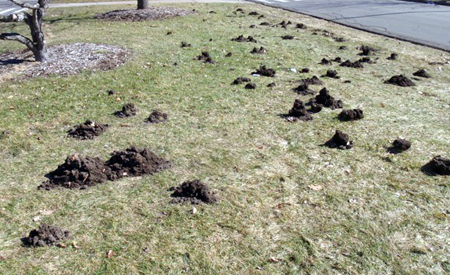
Michigan is home to Eastern Moles, or “talpas.” This type of mole is rarely seen, and are very active most of the day. They will consume about their weight in worms and other soil dwellers during the night and day. They can also cause damage to your plants, flower beds and gardens. Moles are primarily insectivores. Moles hunt and dig in areas of soil that are cool, shaded and moist. These areas are abundant in worms and insects that are led to the moles throughout the tunnel system. They typically have their litters at the end of March and early April. The average life span of a mole is about two to three years. They are not social animals. They tend to avoid confrontation by marking their scent on their daily rounds through the tunnels. Moles have figured out how to create their tunnel system so that they don’t run into other moles. Moles have very few natural enemies, but there are many different things that you can combat them with. If you can eliminate their food supply, the moles will be forced to leave the area. You may also find mole repellents to use, but aren’t as effective and may be very expensive.

The best methods are an exclusion fence or traps. Exclusion fences are buried about 24 to 36 inches deep and left about 3 inches above the surface of the soil. They are bent at the bottom and discourages the mole to continue digging around it. Trapping is the other best method to get rid of moles. It can be very frustrating and disappointing if you have not had experience trapping before. Moles are very aware of their surroundings and can sense quickly when there’s trouble. Gloves are recommended when handling any mole traps, because they have a very keen sense of smell. You must place the traps where the activity is new and the mole is digging. This activity is found usually in the spring and the fall.
There are many different types of traps, a scissor jaw trap, a Victor harpoon trap, and the mole ranger trap, also known as the Duffus and Half Barrel mole trap. The scissor jaw trap works similarly to a mouse trap; it grabs and kills the animal. The harpoon trap spears the mole with sharp spikes as it passes. Finding the right spot to set the trap requires knowledge about mole’s activity patterns. Check your traps daily to see if any have sprung. If you don’t catch them within three days, the trap may have been placed in the wrong location, the runway may have been disturbed too much, or the mole may have detected the trap.

